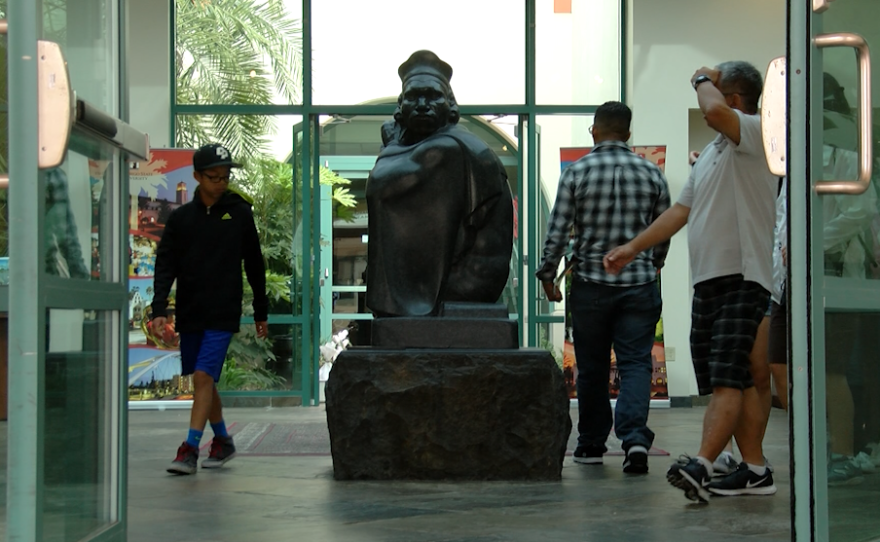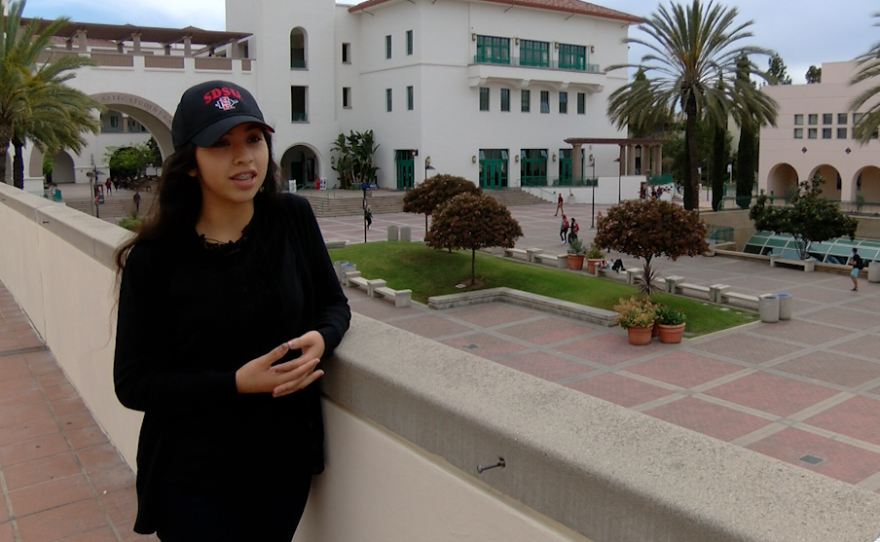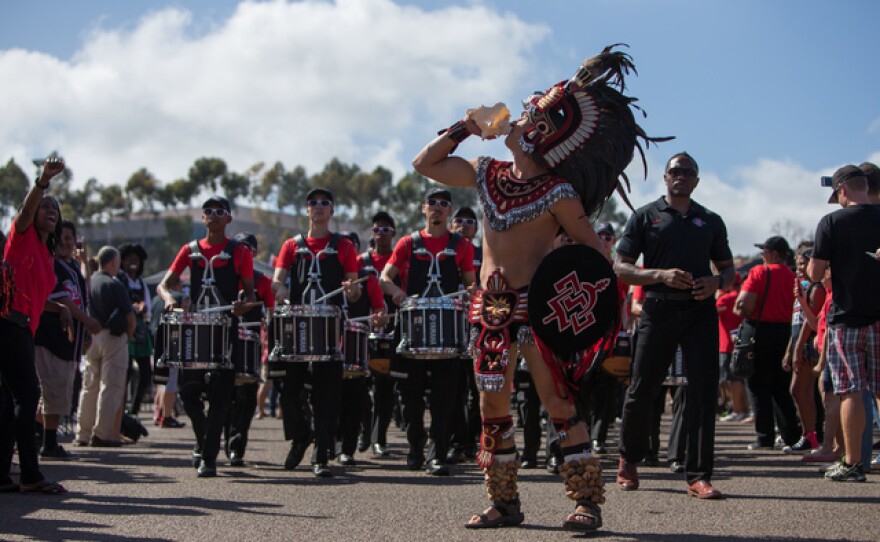In 2009, San Diego State University sanctioned the Sigma Alpha Epsilon chapter on campus for hosting a party with a cowboys and Indians theme.
Ozzie Monge, a lecturer in the school's American Indian Studies Department, says that's a problem for the university.
It's endured student petitions, campus referendums and a ban on Native American mascots. Now San Diego state University's Aztec is coming under fire again. In 2009, San Diego state University sanctioned the Sigma of alpha epsilon chapter on campus for holding a Cowboys and Indians theme party. That was a problem for the University. The University punished students who were dressed like Indians while student -- the University maintains a mascot that looks like an Indian? He presented University administrators with an exhaustive look at the mascot history. He said it was born out of racism and should be canned. This is a relic from a time the country was so openly racist. He says the fascination with this started a long time ago. The missions also brought abuse to Native Americans. There is a schools to -- song that stems from those early days that it's about native -- naked heathens. After the school merged with a Junior college to become San Diego state University, there was a con test -- contest staged. The coach becomes a chief, the athletes are warriors, when they go on the road they are on the warpath, when they win, they massacre. In 1987 the graduating class gifted the University with an Aztec. It became known as Monty Montezuma. They were stomping around in circles in headdresses. I have in a 2014 video with people dancing around acting the Savage. He described the 1995 homecoming game. He chased women clad in buckskin around the campus. He grabbed Monty and so what you doing? They were playing Sage chickens. That is the birth of the mascot at San Diego state University. That is acknowledged even by the University's website. He said in a statement the University welcomes the conversation and that past discussions resulted in an Aztec mascot that is more historically accurate. The more stylized Monty costume was retired. He began wearing it in 1990, and consulted with a professional in Mexico. It has a feathered helmet.'s. It represents strength. You ask a lot of people I think they would say the same thing. He was right. That's what we found we talked to several students on campus. After they heard him speak, the results were different. She said she tries to show school spirit most days. I agree with everything he said, it is hurtful, it is an act of racism and hidden from the students. He doesn't want students like her to feel ashamed. It is up to us to teach this lesson of racism and we keep hiding it to protect the mascot. He is sharing his findings with student groups. He hopes to spark a dialogue on campus. KPBS reporter Megan Burks joins me now. How did the story come to your attention? That this exhaustive history of the mascot, when I spoke to him about it, I realized this was a little bit more than the calls we of her to the and the mascot -- tran 13 in the past. I hadn't heard them before and I went to San Diego state University. I thought it was interesting and thought other people would think so too. It wasn't just is the Aztec native American and be banned, let me sit you down let me tell you what happened and let's talk about it. I thought that was a new approach. For people who are not familiar with the Aztec mascot, how is it used? He is that all of the games. He is bear chested, he has this feathered helmet and a conch shell. In addition to games, there is initiation for freshmen every year where the freshmen walk through the hall and they are Aztecs and they learn the fight song. It is going back to some sort of ritual. There is space painting like there is at all kinds of sports events. He likes to point out where the colors are red and black, sometimes you have people in red and black face. Often it's just the stripes. Is used in all kind away on campus. The logo was used on clothing as well? The logo has changed over the years, it used to be a stylized head and now I believe it is a shield with an arrow through it. Got it. The mascot has been the subject of criticism before. Can you tell us more about that? It seems to come up every few years almost, most recently in 2014, the [NULL] people of color collective challenged it . It failed overwhelmingly. In 2005 there was the NCAA mascot ben -- ben. It was not included in that. Not included? No. They always draw the line at the Aztecs are not alive anymore. They feel that they can represent the culture in a proud way, it is okay, because there is not anybody alive to be offended. Because the Aztecs are extinct to speak? Yes. They did get rid of the Monty head and went to a more hysterically accurate portrayal. What did it look like before they changed it? The logo was this head that was poking -- bulky and large lips and high brow and read. Is the mascot seen nationally as offensive? Just like locally, there are varying opinions about it. There are all cons of lists that journalist put together, that activists put together, that mascots should be banned but are still alive and well. It is definitely a part of the conversation nationally. We hurting your report, it seems that having the name of Aztec is a positive cultural reference? Again, it is this prideful representation that Aztecs are being betrayed as a group with dollar, bravery and strength. In addition to that a lot of people with Mexican heritage feel very connected to the Aztec culture. Anthropologists might argue say that there are very few people alive today that have Aztec blood in their lineage, but the symbol of the Aztec is strong for life in the culture, so a lot of people feel really proud of that representation. The current mascot recently spoke about that in a video. Let's hear from him. I am Mexican myself so I am representing my culture when I am out there. I am not another mascot this is who I am. This is my blood this is where I came from. Where is this conversation going? He would like for the administration to start a dialogue about it. In lieu of that, he is sharing it with various student groups and wants them to have the conversation and it is be aware of more the context of how the mascot came to be. I've been speaking with KPBS reporter Megan Burks . Thank you very much. Thank you.
"Wait a minute. The university punished a fraternity for having a party where students were dressed like Indians, while the university maintains a mascot that is a student dressed like an Indian?" Monge said.
He knows the mascot has in the past endured student petitions, campus referendums and an NCAA ban on Native American mascots. But this spring Monge presented university administrators with an exhaustive look at the Aztec mascot's history. He said the mascot was born out of racism and should be canned.
"This really is a relic from a time when the country was so openly racist," Monge said, "when white supremacy was treated as a fact."
Monge is sharing the Aztec birth story with student groups on campus. He said he hopes they spark a dialogue on campus — if the administration does not.
Recently, Monge spoke as a guest lecturer in a freshman writing class about his findings. He started with the early 1900s, when SDSU was known as the Normal School. Back then a teachers college, the campus tradition drew heavily on Father Junipero Serra and his legacy of teaching Christianity to local tribes people.
Monge said that's when the university's fascination with indigenous cultures began.
The problem for Monge: While Serra’s missions symbolized education to some, it also symbolizes colonialism to Native Americans.
"There's a school song that stems from those early days that talks about native people as naked heathens. 'Serra brings naked heathens to his knee,' and teaches them," Monge said.
In the 1920s the school had a cat as its mascot, presumably inspired by an actual cat that roamed its California mission-inspired halls. When the school merged with a junior college to become San Diego State University, students staged a contest to come up with a new one.

"I call it, 'Le coup de chat,'" Monge said.
The Aztec mascot was born.
"The sports articles take on a whole different life, because now the coach becomes the chief, the athletes are warriors," Monge said. "When they go on the road, they're on the warpath. When they win, they massacre."
In 1937, the graduating class gifted the university the Aztec statue that still sits today in the school's Prospective Students Center. It became known as Monty Montezuma. Archival footage of the dedication ceremony shows a student dressed as Father Serra proselytizing to students dressed in loincloths and headdresses. They're stomping around in circles.
Monge likes to pair that video with a 2014 video of students dancing around a bonfire with the Aztec mascot, their faces painted.
"You know, acting the savage," Monge said. "That shows you the continuity of this particular form of racism."
The first time a student dressed up as the Aztec mascot, called Monty Montezuma until 2000, was in 1941. It was homecoming and Art Munzig ran onto the field from a teepee, chasing women clad in buckskin.
"And the MC grabs him by the arm and says, 'Monty, what are you doing? Why are you chasing those young ladies?' They're playing the Pomona Sagehens. And Monty says, 'Me thinkum them mighty fine sage chickens,'" Monge recounted in a cartoonish voice.
"That is the birth of the mascot at San Diego State University. That is the actual acknowledged — even by the university website — birth of the mascot," Monge said. "The thing they always leave out, though, is the details."
SDSU President Elliot Hirshman did not want to be interviewed for this story but said in a statement the university welcomes the conversation and that past discussions resulted in an Aztec mascot that is more historically accurate. Here's the statement:
"San Diego State University has a long and successful tradition of shared governance. As such, when a policy issue arises, the university engages in a broader discussion of the issue through the appropriate and responsible democratically elected body (e.g., Associated Students, University Senate, etc.). The Aztec issue is not new and, in fact, went through that deliberative process just last year, resulting in a 24-1 vote by the Associated Students to maintain the current status.
"By way of background, the university also went through a broadly based, thorough and thoughtful process in 2000-2003 to study, discuss and revise the university logo and mascot in a manner that is a fitting and appropriate affiliation with Aztec culture and history. The changes were overwhelmingly confirmed in a student referendum then, and again confirmed by an AS resolution in 2006.
"That process — led by a task force of students, faculty, staff, alumni and experts in Aztec culture – provided important guidelines on how best to represent Aztec traditions, build communal spirit and honor specific facets of Aztec culture reflecting the virtues of valor, determination and community-building."
Fred Pierce, an active SDSU alumnus and donor, was part of those discussions in 2000, when the more stylized Monty costume was retired. (His company was the lead developer on a 1990s SDSU redevelopment project that included the building where KPBS is located. The station's license is held by SDSU.) Pierce said he isn't upset or surprised the issue has come up again.

"Universities, by their very nature, are places where debates are supposed to happen," Pierce said. But he said the university has done its due diligence when it comes to the mascot.
"Many of the issues that are raised aren't relevant. They aren't coming from stakeholders, because the fact is there are very few who could claim to be of direct descent from the Aztec nation," Pierce said. "The true stakeholders aren't organized in a place where they can be asked their thoughts, so we turned to historical scholars for historical accuracy."
Carlos Gutierrez wore the Monty uniform beginning in 1990 and said he consulted with an expert in Mexico to design the Aztec Warrior uniform currently seen at games — bare chested with a feathered helmet, a conch shell and ancient symbols for learning.
"People here in San Diego are very grateful to have the name the Aztec," Gutierrez said. "It's been here for so long and is representative of strength. That's what I believe it represents. If you ask a lot of people, I think they would say the same thing."
He was right. Several students that KPBS interviewed on campus said the Aztec symbolizes positive traits, such as valor.
But students who heard Monge's presentation on the history of the mascot had a different take. Esmeralda Quintero, 18, didn't know Monge before he spoke to her class as a guest lecturer.

"I'm, like, 100 percent persuaded by his presentation," said Quintero, who was wearing an Aztec baseball cap. "I agree with everything that he said. It's hurtful. It's an act of racism. It's hidden from the students."
Monge said he doesn't want students like Quintero to feel ashamed. He just wants them to hear the full story.
"There are all these opportunities for us as a group, as a university, to sit and teach this lesson about racism, and we keep hiding it, and hiding it, and hiding it to protect the mascot," Monge said. "That is what's offensive. That is what is the wrong."






